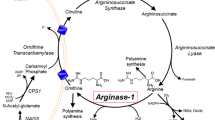Opinion statement
Urea cycle disorders comprise a group of inborn errors of metabolism that represent unique gene-nutrient interactions whose significant morbidity arises from acute and chronic neurotoxicity associated with often massive hyperammonemia. Current paradigms of treatment are focused on controlling the flux of nitrogen transfer through the hepatic urea cycle by a combination of dietary and pharmacologic approaches. Evolving paradigms include the development of cell and gene therapies. Current research is focused on understanding the pathophysiology of ammonia-mediated toxicity and prevention of neural injury.
Similar content being viewed by others
References and Recommended Reading
Busilow SW, Danney M, Waber LJ, et al.: Treatment of episodic hyperammoniemia in children with inborn errors of urea synthesis. N Engl J Med 1984, 310:1630–1634.
Maestri NE, Clissold D, Brusilow SW: Neonatal onset ornithine transcarbamylase deficiency: a retrospective analysis. J Pediatr 1999, 134:268–272.
Busilow SW, Horwich AL: Urea cycle enzymes. In The Metabolic and Molecular Bases of Inherited Disease, edn 8. Edited by Charles R. New York: McGraw-Hill; 2001:1909–1963.
Steiner RD, Cederbaum SD: Laboratory evaluation of urea cycle disorders. J Pediatr 2001, 138:S21-S29.
Tuchman M, McCullough BA, Yudkoff M: The molecular basis of ornithine transcarbamylase deficiency. Eur J Pediatr 2000, 159:S196-S198.
Bonham R, Guthrie P, Downing M, et al.: The allopurinol load test lacks specificity for primary urea cycle defects but may indicate unrecognized mitochondrial disease. J Inher Metab Dis 1999, 22:174–184.
Lee B, Yu H, Jahoor F, et al.: In vivo urea cycle flux distinguishes and correlates with phenotypic severity in disorders of the urea cycle. Proc Natl Acad Sci U S A 2000, 97:8021–8026.
Cooper AJ: Role of glutamine in cerebral nitrogen metabolism and ammonia neurotoxicity. Ment Retard Dev Disabil Res Rev 2001, 7:280–286.
Hazell AS, Butterworth RF: Hepatic encephalopathy: an update of pathophysiologic mechanisms. Proc Soc Exp Biol Med 1999, 222:99–112.
Felipo V, Butterworth RF: Neurobiology of ammonia. Prog Neurobiol 2002, 67:259–279. These authors studied the neuropathology of hyperammonemic syndromes and the effects of acute or chronic ammonia in the astrocytes, which are the most affected cells in the brain.
Suarez I, Bodega G, Fernandez B: Glutamine syntethase in brain: effects of ammonia. Neurochem Int 2002, 41:123–142.
Belanger M, Desjardins P, Chatauret N, Butterworth RF: Loss of expression of glial fibrillary acidic protein in acute hyperammonemia. Neurochem Int 2002, 41:155–160.
Butterworth RF: Glutamate transporters in hyperammonemia. Neurochem Int 2002, 41:81–85. These authors studied the regulation of glutamate-mediated neurotransmission in hyperammonemic states and their correlation with clinical manifestations.
Suarez I, Bodega G, Fernandez B: Glutamine synthetase in brain: effect of ammonia. Neurochem Int 2002, 41:123–142.
Desjardins P, Butterworth RF: The “peripheral-type” benzodiazepine receptor in hyperammonemic disorders. Neurochem Int 2002, 41:109–114. The authors studied the effect of hyperammonemia on neurotransmission and energy metabolism modulating the expression of “peripheral-type” benzodiazepine receptor in astrocytes and the use of positron emission tomography for assessment of the neurologic outcome of hyperammonemia.
Felipo V, Butterworth RF: Neurochemistry of ammonia. Neurochem Int 2002, 41:79.
Mian A, Lee B: Urea cycle disorders as a paradigm for inborn errors of hepatocyte metabolism. Trends Mol Med 2002, 8:583–589.
Batshaw ML, MacArthur RB, Tuchman M: Alternative pathway therapy for urea cycle disorders: 20 years later. J Pediatr 2001, 138:S46-S55.
Thoene JG: Treatment of urea cycle disorders. J Pediatr 1999, 134:255–256.
Lee B, Goss J: Long-term correction of urea cycle disorders. J Pediatr 2001, 138:S62-S71.
James V: The nutritional management of urea cycle disorders. J Pediatr 2001, 138:S40-S45.
Cederbaum JA, LeMons C, Rosen M, et al.: Psychosocial issues and co** strategies in families affected by urea cycle disorders. J Pediatr 2001, 138:S72-S80.
Mathias RS, Kostiner D, Packman S: Hyperammonemia in urea cycle disorders: role of the nephrologist. Am J Kidney Dis 2001, 37:1069–1080.
Ye X: Prolonged metabolic correction in adult OTC deficient mice with adenoviral vectors. J Biol Chem 1996, 271:3639–3646.
Gao GP, Alvira MR, Wang L, et al.: Novel adeno-associated viruses from rhesus monkeys as vectors for human gene therapy. Proc Natl Acad Sci U S A 2002, 99:11854–11859.
Michalak A, Butterworth RF: Ornithine transcarbamylase deficiency: pathogenesis of the cerebral disorder and new prospects for therapy. Metab Brain Dis 1997, 12:171–182.
Oechner M, Steen C, Sturenburg HJ, Kohlschutter A: Hyperammonaemia encephalopathy after initiation of valproate therapy in unrecognized OTC deficiency. Neurol Neurosurg Psychatry 1998, 64:680–682.
Rubenstein JL, Johnston K, Elliott GR, Brusilow SW: Haloperidol-induced hyperammoniemia in a child with Citrullinemia. J Inherit Metab Dis 1990, 13:754–755.
Author information
Authors and Affiliations
Rights and permissions
About this article
Cite this article
Kleppe, S., Mian, A. & Lee, B. Urea cycle disorders. Curr Treat Options Neurol 5, 309–319 (2003). https://doi.org/10.1007/s11940-003-0037-5
Issue Date:
DOI: https://doi.org/10.1007/s11940-003-0037-5




